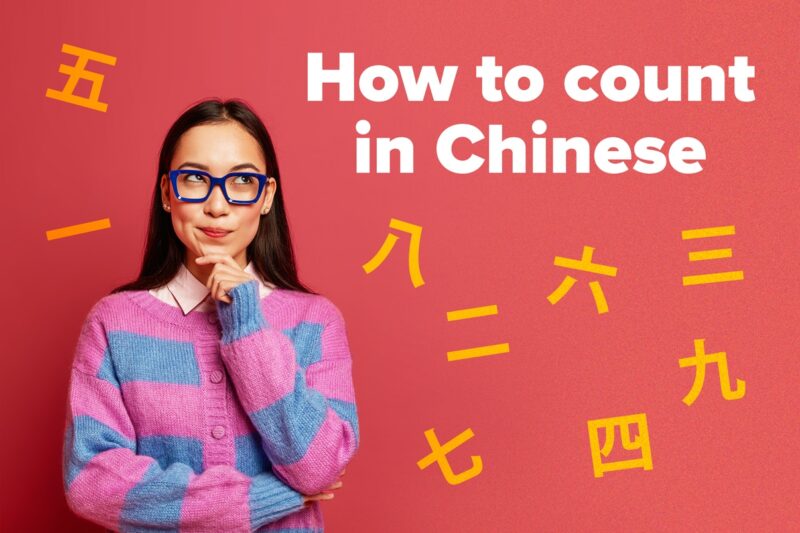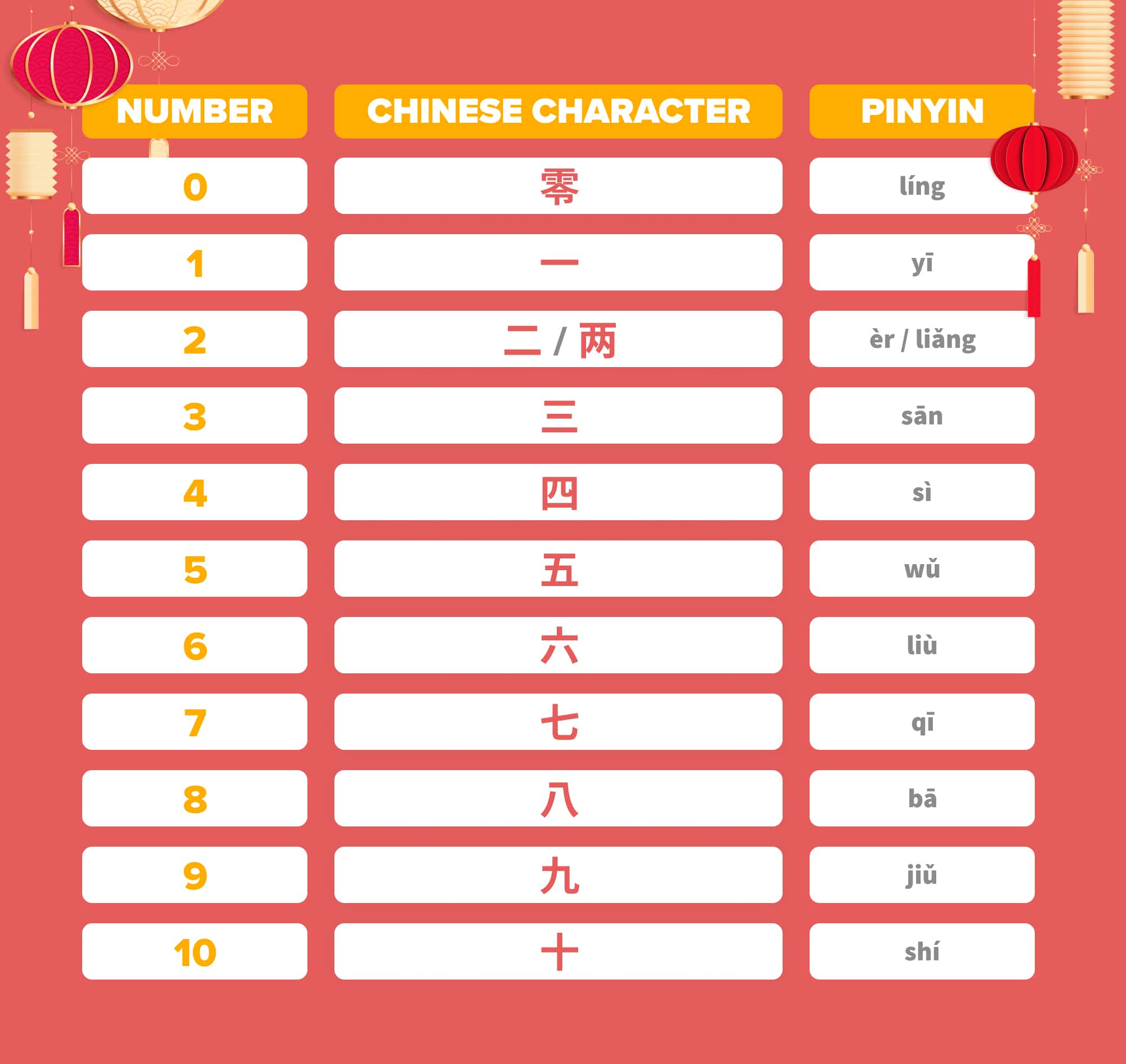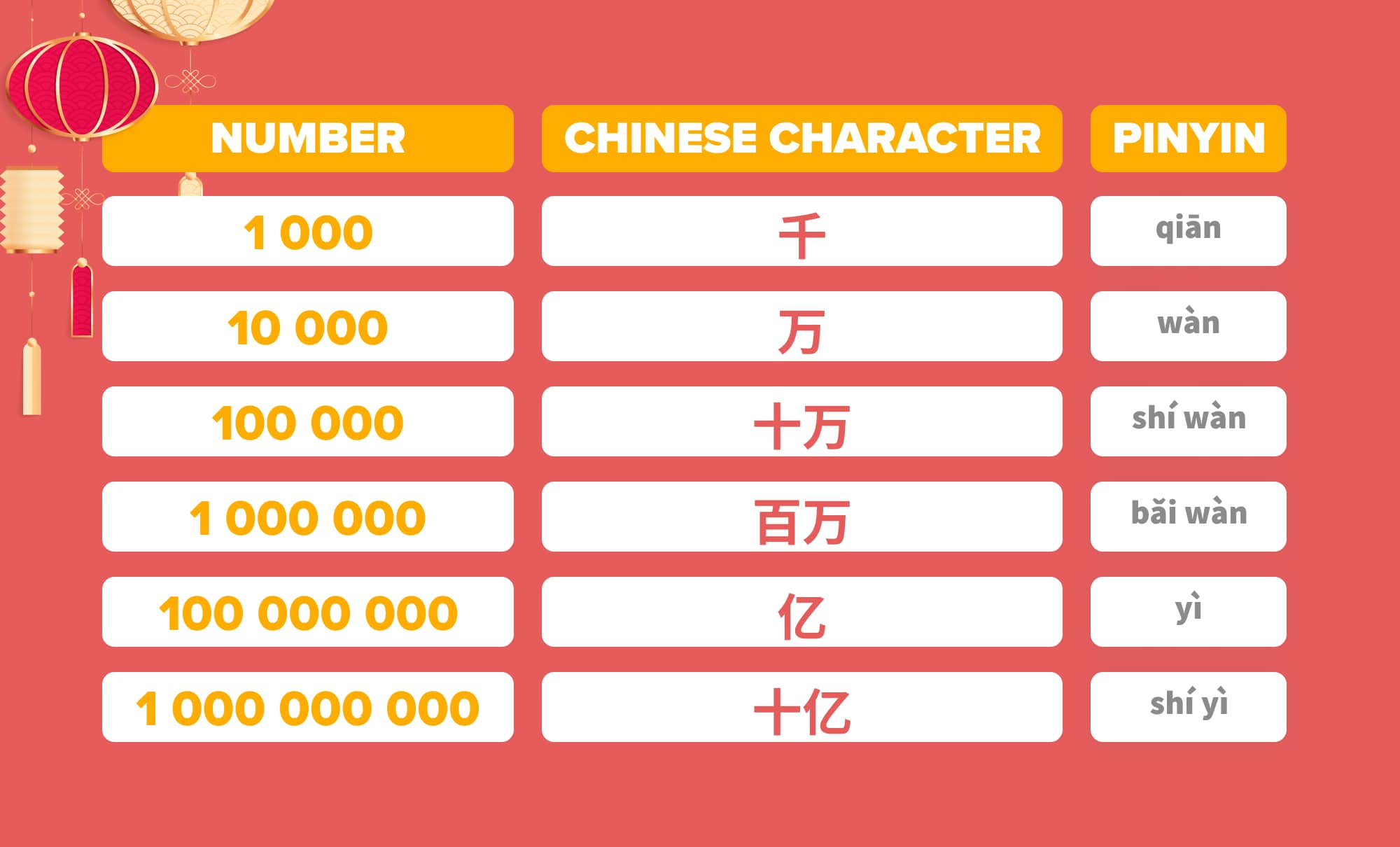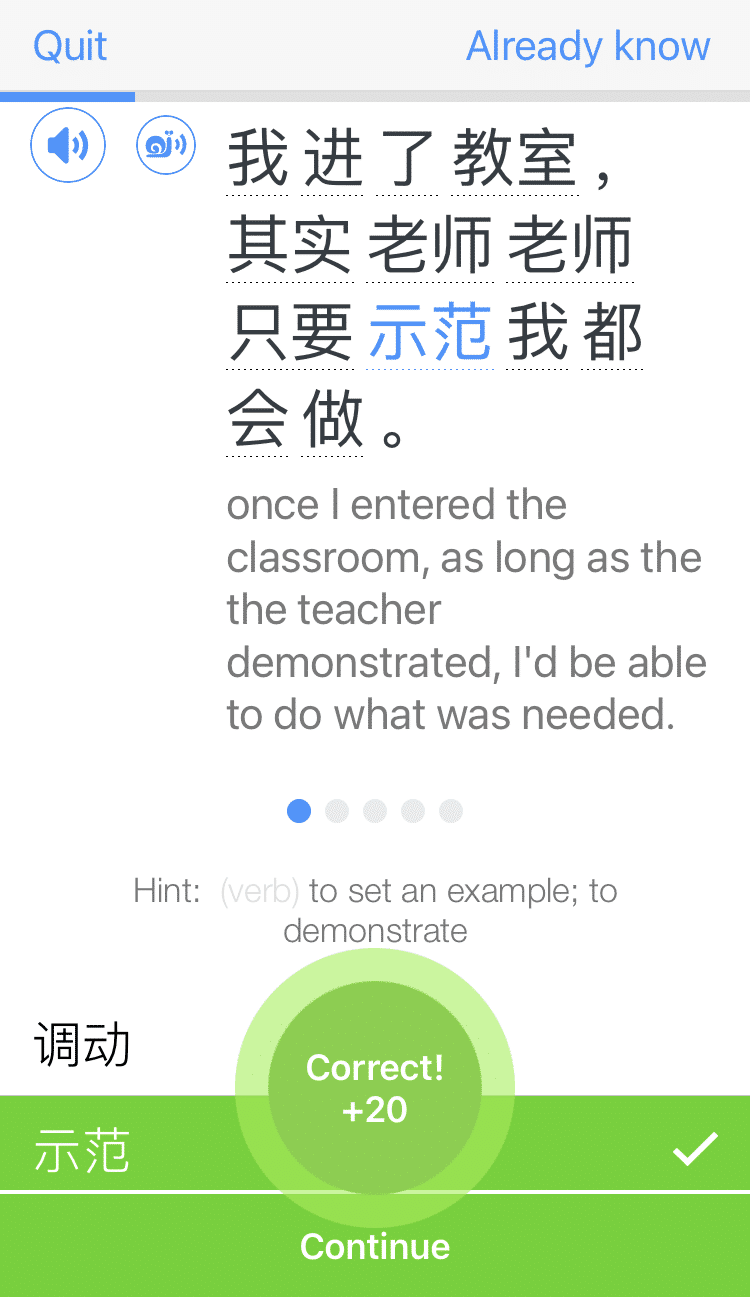Chinese Numbers Guide: How to Count from 1-1000 and Beyond

If you recently started learning Chinese, odds are learning to count is one of your first goals.
Chinese numbers, or 数字 (shù zì), are used for slang, days of the week, listing quantities, talking about money, months of the year, telling time and so much more. And luckily, they follow a pattern that’s easy to learn and makes logical sense.
Take a look at this guide to learn Chinese numbers from one to 1,000 (and more), how to count in Chinese and how to use numbers in everyday sentences.
Contents
- How to Say 0-10 in Chinese
- How to Say 11-20 in Chinese
- How to Say 21-99 in Chinese
- How to Say 100-999 in Chinese
- How to Say 1,000 and Beyond in Chinese
- 10 Essential Chinese Measure Words
- How to Use Chinese Numbers in Conversations
- Ordinal Numbers in Chinese
- Approximate Numbers in Chinese
- How to Count Chinese Numbers with Your Fingers
- Chinese Numbers Practice Quiz
- Resources to Learn More About Chinese Numbers
- And One More Thing...
Download: This blog post is available as a convenient and portable PDF that you can take anywhere. Click here to get a copy. (Download)
How to Say 0-10 in Chinese
The best part about numbers 0-10 in Chinese is that they’ll help you remember every number after them. Think of these numbers as building blocks for numbers 11 and beyond.
| Number | Chinese | Pinyin |
|---|---|---|
| 0 | 零 | líng |
| 1 | 一 | yī |
| 2 | 二 | èr |
| 2 | 两 | liǎng |
| 3 | 三 | sān |
| 4 | 四 | sì |
| 5 | 五 | wǔ |
| 6 | 六 | liù |
| 7 | 七 | qī |
| 8 | 八 | bā |
| 9 | 九 | jiǔ |
| 10 | 十 | shí |
Now you’re probably asking: Why are there two ways to say the number two?
When counting, use 二. When listing quantities, use 两.
For example, 两个人 (liǎng ge rén) is the correct way to say “two people.” But, if you were counting “one, two, three…” you’d say 一,二,三.
How to Say 11-20 in Chinese
Remember how I said that numbers one through 10 are building blocks? Well, you’re about to see that in action.
When you count beyond 10, you continue to use numbers one through 10 along with basic addition.
For example, the number 11 is 十一 (shí yī). The literal translation of this number is “10 plus one.”
Let’s take a look.
| Number | Chinese | Pinyin |
|---|---|---|
| 11 | 十一 | shí yī |
| 12 | 十二 | shí èr |
| 13 | 十三 | shí sān |
| 14 | 十四 | shí sì |
| 15 | 十五 | shí wǔ |
| 16 | 十六 | shí liù |
| 17 | 十七 | shí qī |
| 18 | 十八 | shí bā |
| 19 | 十九 | shí jiǔ |
| 20 | 二十 | èr shí |
Notice that the number 20 literally means “two and 10.”
Easy, right? The good news is that every other number from 30-99 follows this pattern.
How to Say 21-99 in Chinese
Let’s start with counting by tens.
| Number | Chinese | Pinyin |
|---|---|---|
| 30 | 三十 | sān shí |
| 40 | 四十 | sì shí |
| 50 | 五十 | wǔ shí |
| 60 | 六十 | liù shí |
| 70 | 七十 | qī shí |
| 80 | 八十 | bā shí |
| 90 | 九十 | jiǔ shí |
To form the number, just think of it as a multiplication problem.
For example, the number 50 is five and 10 combined, as if to say “five times 10.” The number 80 is the numbers eight and 10 combined, such as “eight times 10.”
But what about forming numbers like 22, 57, 68 or 99?
Take a look at numbers 21 to 29.
| Number | Chinese | Pinyin |
|---|---|---|
| 21 | 二十一 | èr shí yī |
| 22 | 二十二 | èr shí èr |
| 23 | 二十三 | èr shí sān |
| 24 | 二十四 | èr shí sì |
| 25 | 二十五 | èr shí wǔ |
| 26 | 二十六 | èr shí liù |
| 27 | 二十七 | èr shí qī |
| 28 | 二十八 | èr shí bā |
| 29 | 二十九 | èr shí jiǔ |
Notice the pattern? The equation is simple:
The number 2-9 + 十 + the number 1-9
How to Say 100-999 in Chinese
Counting from 100 to 999 is about as easy as counting from 21-99. Let’s take a look at the pattern:
| Number | Chinese | Pinyin |
|---|---|---|
| 100 | 一百 | yī bǎi |
| 200 | 二百 | èr bǎi |
| 200 | 两百 | liǎng bǎi |
| 300 | 三百 | sān bǎi |
| 400 | 四百 | sì bǎi |
| 500 | 五百 | wǔ bǎi |
| 600 | 六百 | liù bǎi |
| 700 | 七百 | qī bǎi |
| 800 | 八百 | bā bǎi |
| 900 | 九百 | jiǔ bǎi |
Pretty simple, right? The formula is as follows: the number one through nine plus 百 (bǎi) — hundred.
Now, let’s take a look at how to form numbers such as 101, 129, 146 and so on.
一百零一 (yī bǎi líng yī) — 101
一百零二 (yī bǎi líng èr) — 102
一百二十九 (yī bǎi èr shí jiǔ) — 129
一百四十六 (yī bǎi sì shí liù) — 146
四百五十八 (sì bǎi wǔ shí bā) — 458
九百九十九 (jiǔ bǎi jiǔ shí jiǔ) — 999
Notice the pattern: a number one through nine plus 百, then a number zero through nine plus 十 and then a final number zero through nine.
However, keep in mind that to count from numbers 101 to 109, you must add a 零. For example:
一百零一 (yī bǎi líng yī) — 101
一百零二 (yī bǎi líng èr) — 102
一百零九 (yī bǎi líng jiǔ) — 109
When counting from 110 to 119, it’s a little different:
一百一十 (yī bǎi yī shí) — 110
一百一十三 (yī bǎi yī shí sān) — 113
一百一十五 (yī bǎi yī shí wǔ) — 115
一百一十八 (yī bǎi yī shí bā) — 118
一百一十九 (yī bǎi yī shí jiǔ) — 119
The pattern is as follows:
The number 1-9 + 百 + 一 + the number 10-19
How to Say 1,000 and Beyond in Chinese
So far, the patterns of Chinese numbers have been pretty easy to understand. The number system has followed a logical order, and odds are you feel comfortable forming your own numbers from zero to 999.
But above 999, Chinese numbers can get a bit tricky.
In English, we continue putting the word “thousand” after numbers one through nine to count to one million. But in Chinese, there’s a new word for ten thousand. After we reach that number, we never use the word “thousand” again.
Let’s take a look.
| English | Chinese | Pinyin |
|---|---|---|
| thousand | 千 | qiān |
| ten thousand | 万 | wàn |
| hundred thousand | 十万 | shí wàn |
| million | 百万 | bǎi wàn |
| hundred million | 亿 | yì |
| billion | 十亿 | shí yì |
In Chinese, 1,000 to 9,000 is 一千 (yī qiān) to 九千 (jiǔ qiān).
However, 11,000 is not 十一千 (shí yī qiān). The correct way to say 11,000 is 一万一千 (yī wàn yī qiān), which is literally “10,000 plus 1,000.”
Similarly, the number 17,000 is 一万七千 (yī wàn qī qiān), which is 10,000 plus 7,000.
So, to get from 10,000 to 90,000, the formula is as follows:
The number 1-9 + 万
For example, the number 50,000 is 五万 (wǔ wàn). The number 30,000 is 三万 (sān wàn).
What about 58,000? That would be 五万八千 (wǔ wàn bā qiān).
The same applies to numbers 十万 (shí wàn) — a hundred thousand to 十亿 (shí yì) — billion.
10 Essential Chinese Measure Words
Measure words are an essential part of Chinese grammar.
In Chinese, you can’t simply say “I want two apples.” You have to insert a measure word in between the number two and the word “apples.”
Leaving out measure words is one of the few errors in Chinese that many native speakers won’t be able to look past using context alone.
Although you might think leaving out a measure word isn’t a big deal, it could mean that native speakers simply won’t understand what you’re trying to say.
Let’s dive into the first 10 measure words you should learn.
| Chinese | Pinyin | Usage | Example |
|---|---|---|---|
| 只 | zhī | counting animals | 两只小狗 (liǎng zhī xiǎo gǒu) — two puppies |
| 间 | jiān | counting rooms | 三间房 (sān jiān fáng) — three rooms |
| 棵 | kē | counting plants and trees | 八棵树 (bā kē shù) — eight trees |
| 张 | zhāng | counting anything flat | 一张纸 (yì zhāng zhǐ) — one piece of paper |
| 双 | shuāng | counting pairs | 一双袜子 (yì shuāng wà zi) — one pair of socks |
| 辆 | liàng | counting vehicles | 三辆车 (sān liàng chē) — three cars |
| 本 | běn | counting books | 两本书 (liǎng běn shū) — two books |
| 家 | jiā | counting buildings, gatherings and establishments | 一家公司 (yì jiā gōng sī) — one company |
| 位 | wèi | counting people | 三位老师 (sān wèi lǎo shī) — three teachers |
And lastly, there’s 个 (ge/gè) — generic measure word.
This measure word can be used to count anything. If you find yourself stuck in a situation where you don’t know which measure word to use, just use 个 (ge/gè).
For example:
两个苹果 (liǎng ge píng guǒ) — two apples
How to Use Chinese Numbers in Conversations
Now that you know how to count in Chinese, let’s look at how Chinese numbers are used in real-life conversations—such as giving your phone number, mentioning your age or asking for the price of something.
Phone Numbers in Chinese
First, let’s start with the basics. To ask for someone’s phone number, say:
你的电话号码是多少?
(nǐ de diàn huà hào mǎ shì duō shǎo?)
What is your phone number?
电话号码 (diàn huà hào mǎ) means “phone number.”
So to answer, you’d say:
我的电话号码是……
(wǒ de diàn huà hào mǎ shì…)
My phone number is…
Giving your phone number in Chinese is the same as in English. Simply say the digits one by one until you’ve completed the number sequence. For example:
我的电话号码是8319036452。
(wǒ de diàn huà hào mǎ shì bā sān yāo jiǔ líng sān liù sì wǔ èr.)
My phone number is 8319036452.
When people tell phone numbers, the number 1 (yī) is often pronounced as “yāo”. Do you know why? -The pronunciation of 1 (yī) is too similar to 7 (qī) and it often brings trouble. To make things easier, people pronounced 1 as “yāo”.
Age and Birthdays in Chinese
To express your age in Mandarin Chinese, you can use one of the following two patterns:
我……
(wǒ…)
I am…(years old)
我……岁
(wǒ…suì)
I am…years old
In my personal experience, the second one seems to be the most common.
For example, if you are 25 years old, you would say:
我二十五。
(wǒ èr shí wǔ.)
I am 25 (years old).
我二十五岁。
(wǒ èr shí wǔ suì.)
I am 25 years old.
To say your birthday in Mandarin, you can use the following pattern:
我的生日是……年……月……日
(wǒ de shēngrì shì…nián…yuè…rì)
My birthday is on the…of…in the year…
In Chinese, people mostly use the order “year-month-date”.
For example:
我的生日是一九九零年五月十日。
(wǒ de shēng rì shì yī jiǔ jiǔ líng nián wǔ yuè shí rì。)
My birthday is on May 10th, 1990.
To learn more about how to talk about dates in Chinese, I highly recommend checking out this post:
The Complete Guide to Months in Chinese (and the Lunar Calendar) | FluentU Chinese
Learn how to say all 12 months in Chinese, as well as the Chinese holidays. Additionally, we cover years and dates in Mandarin, along with useful phrases for describing…
Talking About Prices in Chinese
First, you need to know that the currency of China is 元 (yuán). But when talking about prices, the word 块 (kuài) is often used instead of 元.
You’d use this simple formula to say how much something costs in Chinese:
。。。块
(…kuài)
…yuan
For example, if you want to say something costs 50 yuan, you would say:
五十块
(wǔ shí kuài)
50 yuan
If the price includes smaller units such as 角 (jiǎo) or 分 (fēn), you can add them after the yuan part. For example:
三块五角
(sān kuài wǔ jiǎo)
3 yuan and 50 cents
You can check out this blog post to learn more about money in Chinese:
https://www.fluentu.com/blog/chinese/money-in-chinese/
Ordinal Numbers in Chinese
Chinese ordinal numbers show placement, rank or sequences of nouns.
For example, ordinal numbers in English are words like “first,” “second,” “third,” “fourth” and so on.
In Chinese, this is really simple. Instead of tacking on a few extra letters to the end of the number like in English, just add 第 (dì) before the number.
For example:
第一次 (dì yī cì) — 1st time
第二季 (dì èr jì) — 2nd season (of a TV show)
第三个问题 (dì sān gè wèn tí) — 3rd question
Approximate Numbers in Chinese
When we aren’t sure of an exact number, we use words like “a few,” “about,” “around” and “[number]-ish” in English.
In Chinese, you can use these expressions:
几个 (jǐ ge) — a few, several (for numbers between 1-9)
[number ≥10] 多 (duō) — more than [number ≥10]
十几 (shí jǐ) — more than 10, 10 and some odd… (i.e. “10 and some odd hours”)
几十 (jǐ shí) — a number between 20 and 99
三五个 (sān wǔ gè) — a colloquial way of saying “a few” (literally “three five”)
[number] 左右 / 差不多 (zuǒ yòu / chà bù duō) — about/around [number]
How to Count Chinese Numbers with Your Fingers
Did you know that counting with your hands in Chinese is different than in English?
In English, we count to 10 using all 10 fingers—or, both hands. But in Chinese, you only need one hand to count to 10!
Here’s a simple tutorial from the Yoyo Chinese YouTube channel that explains how to count to 10 using Chinese hand gestures:
Chinese Numbers Practice Quiz
Now it’s time to put your new vocabulary to the test! Translate the following numbers and phrases of this quiz, then check your answers below.
1. 20
2. 35
3. 13
4. 143
5. 1,981
6. three apples
7. four people
8. I am 23 years old
9. 63 RMB/yuan
10. 5th question
11. My birthday is November 10
Answers:
1. 二十 (èr shí)
2. 三十五 (sān shí wǔ)
3. 十三 (shí sān)
4. 一百四十三 (yī bǎi sì shí sān)
5. 一千九百八十一 (yī qiān jiǔ bǎi bā shí yī)
6. 三个苹果 (sān gè píng guǒ)
7. 四个人(sì gè rén)/四位 (sì wèi)
8. 我二十三岁 (wǒ èr shí sān suì)
9. 六十三块 (liù shí sān kuài)/六十三元(liú shí sān yuán)
10. 我的生日是十一月十日 (wǒ de shēng rì shì shí yī yuè shí rì)
Resources to Learn More About Chinese Numbers
Numbers are used to talk about lots of topics in Chinese!
You can continue expanding your Chinese numbers knowledge with these resources:
https://www.fluentu.com/blog/chinese/days-of-the-week-in-chinese/
How to Tell Time in Chinese: Vocabulary, Times of the Day, Expressions and More | FluentU Chinese Blog
If you want to learn how to tell the time in Chinese, read this ultimate guide. You’ll find how to tell time, count the hours, minutes and quarters, use time-related…
https://www.fluentu.com/blog/chinese/chinese-measure-words/
https://www.fluentu.com/blog/chinese/chinese-number-slang/
https://www.fluentu.com/blog/chinese/math-in-chinese/
The best way to solidify your new Chinese numbers knowledge is by using them in real life, and absorbing how native speakers do.
Luckily, you don’t have to go to China to do so. You can use native material online, like the videos on FluentU.
FluentU takes authentic videos—like music videos, movie trailers, news and inspiring talks—and turns them into personalized language learning lessons.
Start using the FluentU website on your computer or tablet or, better yet, download the FluentU app from the iTunes or Google Play store. Click here to take advantage of our current sale! (Expires at the end of this month.)
Congratulations—you can now count to one billion in Mandarin Chinese!
Simple, right?
Keep practicing and soon, you’ll find Chinese numbers come to you easily.
Download: This blog post is available as a convenient and portable PDF that you can take anywhere. Click here to get a copy. (Download)
If you want to continue learning Chinese with interactive and authentic Chinese content, then you'll love FluentU.
FluentU naturally eases you into learning Chinese language. Native Chinese content comes within reach, and you'll learn Chinese as it's spoken in real life.
FluentU has a wide range of contemporary videos—like dramas, TV shows, commercials and music videos.
FluentU brings these native Chinese videos within reach via interactive captions. You can tap on any word to instantly look it up. All words have carefully written definitions and examples that will help you understand how a word is used. Tap to add words you'd like to review to a vocab list.
FluentU's Learn Mode turns every video into a language learning lesson. You can always swipe left or right to see more examples for the word you're learning.
The best part is that FluentU always keeps track of your vocabulary. It customizes quizzes to focus on areas that need attention and reminds you when it’s time to review what you’ve learned. You have a 100% personalized experience.
Start using the FluentU website on your computer or tablet or, better yet, download the FluentU app from the iTunes or Google Play store. Click here to take advantage of our current sale! (Expires at the end of this month.)And One More Thing...













